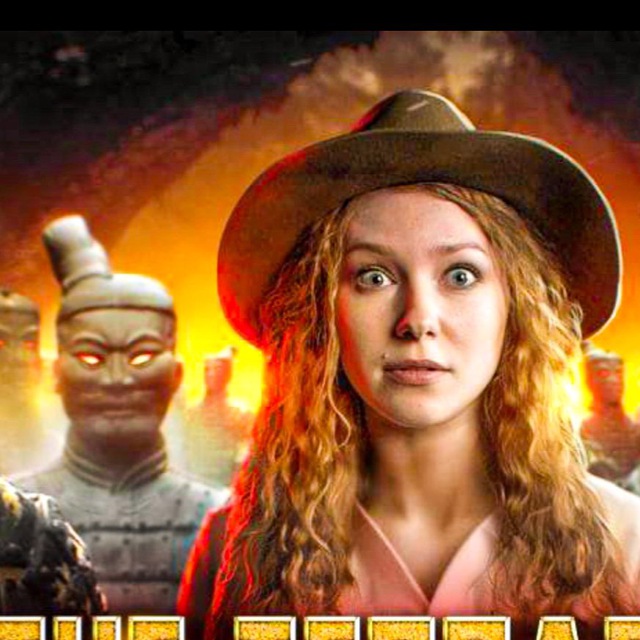831
subscribers

Can't Join? t.me/ahistory1
831
subscribers
Updated: Nov 5, 2025
Join me on History Adventures channel ( Youtube.com/@History-Adventures ) to explore ancient mysteries and lost civilizations :-)

ahistory1
July 16, 2024, 22:03

Catastrophe 12,800 Years Ago: The Beginning of Historical Time ☄️
Younger Dryas:
A period of sudden cooling between 12,800 and 11,600 years ago when the Earth was emerging from the last Ice Age. It was a significant time for humanity, marked by the transition from nomadic hunter-gatherers to settled societies and the dawn of modern civilization.
Cosmic Impact Hypothesis:
12,800 years ago, Earth collided with a meteor or multiple meteors. This event triggered a "nuclear winter" and global cooling, leading to population decline and cultural changes. It also contributed to the extinction of megafauna (mastodons, mammoths, giant sloths).
Supporting Evidence:
Impact crater beneath the Hiawatha Glacier in Greenland (31 km in diameter, dated to 12,800 years ago). Anomalies in Younger Dryas sediment layers across multiple continents: black matte layer from biomass burning, nanodiamonds, and melt-glass particles. A spike in platinum levels, extending to South America and Africa.
The cosmic impact caused the release of meltwater from glaciers, disrupting warm ocean currents.
#neolithic #10000BCE
Join us: History Adventures

ahistory1
June 20, 2024, 15:11

Who domesticated whom? 🤔
Or the Neolithic Agricultural Revolution (began 10,000 BCE).
With the transition to agriculture, the life of humans, who were previously hunter-gatherers, did not improve. There was more food, so the population increased, but food supplies were depleted more quickly.
Instead of a varied diet, people began to eat almost exclusively grains, leading to weakened bodies due to a lack of protein and vitamins.
🌱However, this did not grains—wheat, corn, and rice—from spreading around the world, becoming completely dependent on humans, and humans on them.
🐈 People cultivated these grains, protecting them from rodents, which led to the domestication of cats that became the guardians of the crops.
It seems that grains "domesticated" humans, and cats became the second most beneficial group.🤠
⏳In the long term, this transition allowed our ancestors to begin social evolution, thanks to which we now live in cities and engage in intellectual labor.
By the way, in response to the needs of social changes during the transition from primitive hunting to agriculture, there was a replacement of zoomorphic gods with anthropomorphic ones, to varying degrees replacing old cults with new ones.
#neolithic #10000BCE
Join us: History Adventures

ahistory1
June 18, 2024, 8:03

Why did Roman armor imitate musculature? ⚔️🛡
As early as the 5 century BCE, ancient Greeks began making cuirasses that replicated the contours of human musculature. The Romans adopted these cuirasses and called them Lorica Musculata. The polished bronze armor looked impressive, giving the warrior the appearance of an invincible being. The muscular relief enhanced the cuirass's strength due to the added rigidity.
These cuirasses were often custom-made and expensive, so they were primarily worn by high-ranking officers: tribunes, praetors, and legates.
#weapon #500BCE
Join us: History Adventures
ahistory1
June 11, 2024, 18:37

Why do various civilizations have similar mythological creatures? ✨
(Using the Etruscans from 800-600 BCE as an example)
In the 8th century BCE, a struggle for control of the Mediterranean began between the Etruscans, Greeks, and Phoenicians, which was later won by the Romans. At this time, Rome was still a small settlement.
🏺More amphorae from the archaic Greek period have been found in Italy than in Greece because the Greeks used amphorae as trade goods and containers for transport, while for the kings of Etruscan cities, amphorae were prestigious items, often taken with them into tumuli, the so-called megalithic tombs shaped like burial mounds, when they passed away. Due to cultural exchange, the Etruscans borrowed Greek mythological themes and deities: Apulu (Apollo), Aritimi (Artemis), and others.
🧿Trade with the Phoenicians introduced Eastern themes into Etruscan culture. Scarabs, magical Egyptian amulets in the form of scarabs, and sphinxes began to appear. Mesopotamian themes also emerged, featuring winged creatures, griffins, and manticores.
Purchased items with images quickly became part of Etruscan culture.
Join us: History Adventures

ahistory1
June 6, 2024, 5:25

Ancient Boxing 🥊
One of the most practiced sports by the Etruscans, or rather, the most popular, was fist fighting. This sport was introduced in the competitions at Olympia in 688 BCE.
Most likely, the rules were different back then. A characteristic of ancient fist fighting was a peculiar defensive stance with arms raised very high to protect the face, much more so than in modern boxing: therefore, it is believed that in Etruscan fist fighting, only punches to the face were allowed. This rule seems to be confirmed by written sources (e.g., Virgil, in the fifth book of the Aeneid). It is said that fighters often wrapped their hands and forearms with leather straps and armed themselves with rings to strike their opponents more forcefully.
In the fight, all strikes were valid, and very often it ended with the death of one of the fighters. Additionally, in ancient fist fighting, both in Greece and Etruria, weight categories might not have existed: in a Greek inscription found in Francavilla Marittima, an athlete boasts of a victory where he fought opponents of different weights.
🎶 A unique feature of Etruscan fist fighting was the musical accompaniment: in fact, fighters often appear alongside a musician attempting to play a characteristic double flute. It is believed that the music was used to control the movements of the athletes, giving rhythm to the fighters' actions.
Join us: History Adventures
ahistory1
May 11, 2024, 12:37

The oldest animation 🐐
3200 BCE, Iran, Shahr-i Sokhta (“Burnt City”).
In this ancient artwork, which can be considered the world's first animation, the artist depicted a goat jumping towards a tree and eating its leaves.
On some other clay items found in the Burnt City, repetitive images are depicted, but none of them indicate any movement.
🗺️ 30°39'00.7"N 61°24'00.5"E
Join us: History Adventures
ahistory1
March 11, 2025, 17:14

Stream in 2 hours - see you there: https://x.com/btc_charlie/status/1899508045740122438

ahistory1
May 3, 2024, 20:03

Common ancient source of myths or shared psychological experience of humanity? 🧠✨
Around 3000 BCE, the area of modern Athens was already a settlement that became a city in Mycenaean Greece, and by the first millennium BCE, it still bore the name of a goddess who was a patron of snakes and birds in the Neolithic era.
Mythology states that the first ruler of Attica, Cecrops, was a son of Gaia-Earth (feminine principle), had a snake's body and dual (female and male) nature, and was a judge in the dispute between Poseidon (Zeus’s brother) and Athena (daughter of Zeus) over who would present the best gift to the inhabitants of Attica and thus gain possession of it. Poseidon struck with his trident and opened a spring of seawater in the rock, whereas Athena’s spear strike caused an olive tree to grow. The tree was more favored by the residents of Cecropia than the spring of salty seawater, and Athena became the main deity of Attica and the city named in her honor.
The genderless ruler Cecrops, with a snake's body, draws attention. Moreover, the entire myth has clear parallels with the myth of the fruit from the Tree of Life in Paradise. Here we find all the elements: the male principle - Poseidon/Adam, the female principle - Athena/Eve, God - Zeus, the serpent - Cecrops, the Tree of Life - the olive tree, the fruit of the Tree of Life - the olive, which was favored over Poseidon's gift.
Religious narratives have many plot parallels in the traditions of peoples living all over the world…
Join us: History Adventures

ahistory1
April 30, 2024, 17:41

Echoes of the cult from the Göbekli Tepe temple complex in other cults. 🐍
Crete. In 1903, figurines of women with snakes were discovered in the ruins on Crete, dated to 1600 BCE. One of them held a snake in her hand, while another resembled a statue from Göbekli Tepe.
Greece.
▫️In ancient Greek mythology, Hercules as a child strangled two snakes sent by Hera, which is related to the goddess Gaia and symbolizes the victory over evil.
▫️Medusa the Gorgon was turned into a monster with snake hair by Athena after being violated by Poseidon.
▫️The Trojan priest Laocoön, who violated the commandments of Apollo, was killed by snakes sent by the gods.
▫️Images of Athena often include snakes, emphasizing her connection with them. Additionally, Athena is associated with birds, transforming herself into an owl, her symbol.
Mesopotamia. A plaque depicts a nude goddess with wings on her back and bird claws instead of feet. The goddess holds snakes in her hands, with owls standing beside her. The image has clear iconographic kinship with the Knossos figurines from Crete.
Similar images of a goddess with snakes have been found in other parts of Eurasia and even America.⚪️
Part 1/5. T-shaped pillars.
Part 2/5. Snakes.
Part 3/5. Vultures.
Join us: History Adventures
ahistory1
August 6, 2024, 15:29
